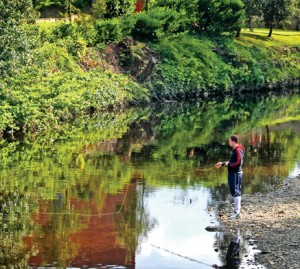
Dublin is unique among European cities in having three naturally reproducing salmon rivers within the city boundaries; the Liffey, the Tolka and the Dodder. While salmon have the run of the former two, in the Dodder they are confined to the area downstream of Donnybrook.
This is due to a series of eight impassable, three metre high, man-made weirs constructed over 200 years ago, at intervals between Donnybrook and Tallaght.
This is set to change, however, with new plans approved to modify the weirs in order to allow the salmon (as well as sea trout) full access to the entire length of the Dodder. Martin O’Grady of Inland Fisheries Ireland, is involved in the project and spoke to NewsFour about the plans.
“When we heard there was to be a flood release programme in the lower Dodder we suggested the engineers consider putting in fish passes, as there is an existing salmon and sea trout population in what is one of the shortest rivers in Europe,” O’Grady told NewsFour. “As it is, the fish can come up past the Aviva Stadium but only as far as Donnybrook Garage.”
The weirs were constructed in pre-Victorian times in order to power mills, long before the advent of electricity. “There was no thought given to fish passage at that time so, once the weirs were built, the salmon population became extinct. As a result, it’s well over 200 years since fish had access to places like Templeogue and Firhouse,” O’Grady says. He credits the quality of the Dodder water in attracting salmon, “The water is very clean, which is a prerequisite for a salmon population.” .
Along with fish, another interesting creature, the Sea Lamprey, which O’Grady describes as “a very ugly-looking animal that looks like an eel with a sucker in place of a mouth”, is expected to make use of the river. The project is expected to be completed within two years.
By Eric Hillis

